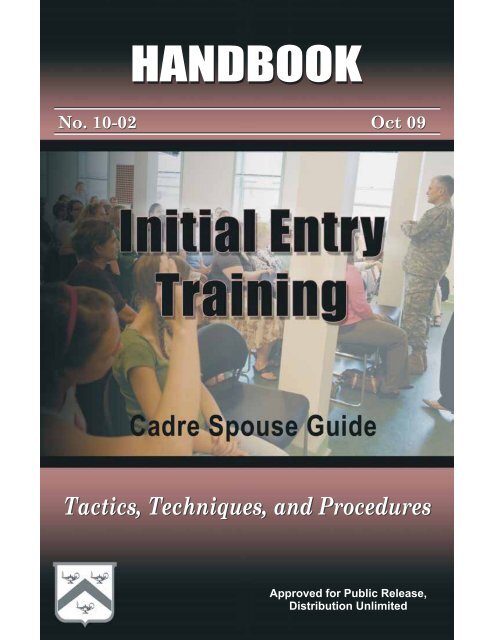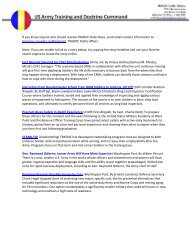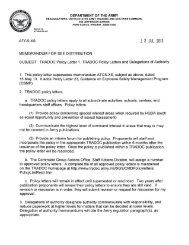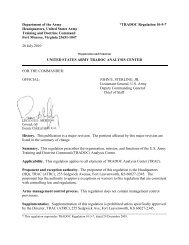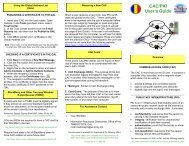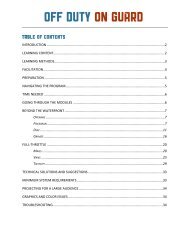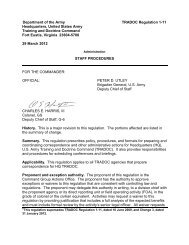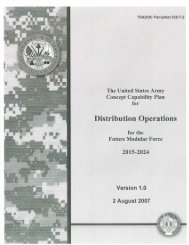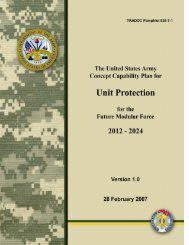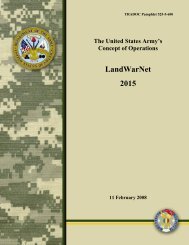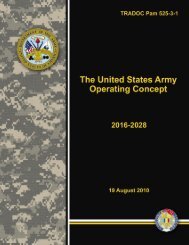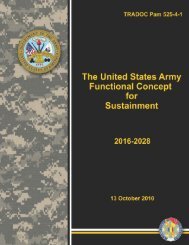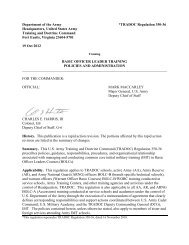Cadre Spouse Guide - TRADOC - U.S. Army
Cadre Spouse Guide - TRADOC - U.S. Army
Cadre Spouse Guide - TRADOC - U.S. Army
You also want an ePaper? Increase the reach of your titles
YUMPU automatically turns print PDFs into web optimized ePapers that Google loves.
HANDBOOK<br />
No. 10-02 Oct 09<br />
Tactics, Techniques, and Procedures<br />
Approved for Public Release,<br />
Distribution Unlimited
FOREWORD<br />
i
Table of contents<br />
Initial Entry Training <strong>Cadre</strong> <strong>Spouse</strong> <strong>Guide</strong><br />
Purpose 1<br />
<strong>Army</strong> Family Covenant 3<br />
What is IET? 4<br />
IET Installations 5<br />
Roles of IET Leaders 6<br />
IET Phases 8<br />
Valued Time and Schedules 9<br />
Religious Support 14<br />
Education 16<br />
<strong>Spouse</strong> Education and Employment 19<br />
Family Activities 20<br />
Dual Military 21<br />
Reserve and National Guard 22<br />
Family Readiness Group 23<br />
Responsibility Shift 25<br />
Transition Tips 27<br />
Mental Health 28<br />
Stress Relief 29<br />
Post-Traumatic Stress Disorder 30<br />
Agency Support 31<br />
Child, Youth, and School Services 33<br />
<strong>Army</strong> Training Centers 35<br />
Information Websites 36<br />
IET-Specific Acronyms 37<br />
iii
Table of contents<br />
Center for <strong>Army</strong> Lessons Learned<br />
Director Colonel Robert W. Forrester<br />
Project Analyst Michael Pridgen<br />
Production Coordinator Kristine Bell<br />
Distribution Manager Candice Miller<br />
The Secretary of the <strong>Army</strong> has determined that the publication of this periodical<br />
is necessary in the transaction of the public business as required by law of<br />
the Department.<br />
Unless otherwise stated, whenever the masculine or feminine gender is used,<br />
both are intended.<br />
Note: Any publications (other than CALL publications) referenced in this product,<br />
such as ARs, FMs, and TMs, must be obtained through your pinpoint distribution<br />
system.<br />
iv
PURPOSE<br />
This handbook is designed to help you as a new cadre spouse<br />
member to become ―Family Strong.‖<br />
It provides basic knowledge about Initial Entry Training (IET), new<br />
responsibilities of your cadre member, and advice to prepare<br />
yourself better for the IET environment. Family readiness is when<br />
Families are prepared and equipped with the skills and tools to meet<br />
the challenges of military life successfully.<br />
We also want to stress that IET is extremely important for our <strong>Army</strong> as<br />
it enables the generating force to man the field units. When you<br />
support your spouse, you help accomplish this important mission.<br />
The point of contact for this handbook is Mr. James E. Walthes,<br />
Director, Doctrine and Training Development Division<br />
(803.751-6511/1137 or DSN 734-6511/1137;<br />
jim.walthes@us.army.mil).<br />
1
ARMY Family covenant<br />
Our strong support to Families still exists in Initial Entry Training.<br />
Like any other unit, we give Families the highest priority.<br />
The <strong>Army</strong> Family Covenant<br />
We recognize…<br />
...the commitment and increasing sacrifices<br />
that our Families are making every day.<br />
...the strength of our Soldiers comes from<br />
the strength of their Families.<br />
We are committed…<br />
...to providing Soldiers and Families a Quality of Life that is<br />
commensurate with their service.<br />
...to providing our Families a strong, supportive environment<br />
where they can thrive.<br />
...to building a partnership with <strong>Army</strong> Families that enhances<br />
their strength and resilience.<br />
We are committed to improving Family readiness by:<br />
• Standardizing and funding existing Family programs and<br />
services<br />
• Increasing accessibility and quality of healthcare<br />
• Improving Soldier and Family housing<br />
• Ensuring excellence in schools, youth services, and child care<br />
• Expanding education and employment opportunities for Family<br />
members<br />
3<br />
Chief of Staff of the <strong>Army</strong><br />
General George W. Casey Jr.
What is Iet?<br />
What is Initial Entry Training (IET)?<br />
Your cadre spouse is involved in one of the following:<br />
Basic Combat Training<br />
Basic Combat Training (BCT), transforms a civilian into a Soldier. It is a<br />
significant time in a Soldier’s life. BCT is meant to be rigorous and<br />
challenging. During this time, individuals adapt to a new career and<br />
life for their Families. A typical BCT day entails early mornings, long<br />
days, late nights, and information overload. BCT is designed to give a<br />
Soldier the experience and skills required in today’s <strong>Army</strong>. We are<br />
confident that as a Soldier progresses through training, he or she will<br />
grow in self-confidence, individual knowledge, and physical strength.<br />
Led by Drill Sergeants, Soldiers have leaders who are confident,<br />
strong, and never ask Soldiers to do anything they will not do<br />
themselves. Drill Sergeants and support personnel are with Soldiers<br />
from the time they arrive to the day they graduate. Soldiers are under<br />
constant supervision (mainly during the first few weeks of training - Red<br />
Phase), resulting in cadre having long days and working most<br />
weekends.<br />
Advanced Individual Training<br />
Advanced Individual Training (AIT) follows BCT. AIT focuses on the job<br />
that Soldiers will be doing. As they learn their specific jobs, they<br />
continue to reinforce those skills learned in BCT. AIT courses vary in<br />
length from five weeks to over one year depending on Military<br />
Occupation Specialty (MOS). Although supervision varies more in AIT,<br />
cadre still work long days and many weekends.<br />
One Station Unit Training<br />
One Station Unit Training (OSUT) combines BCT and AIT in the same<br />
unit and cadre. One Station Unit Training is organized for certain MOSs<br />
such as Infantry, MP, Engineer, and Armor. The transition from BCT to<br />
AIT is seamless, and graduations are celebrated at the end of OSUT.<br />
Again, hours are long and training is conducted on weekends.<br />
4
Iet INSTALLATIONS<br />
Initial Entry Training (IET) is conducted all over the United<br />
States. The map above depicts all installations with IET units on<br />
them. Realize that there are thousands of cadre spouses in<br />
IET - you are not alone.<br />
Welcome to the large IET <strong>Army</strong> Family!<br />
5
What are important IET roles?<br />
<strong>Cadre</strong><br />
<strong>Cadre</strong> are all military, permanent party members or civilian<br />
personnel that command, supervise, instruct, train, or directly<br />
support IET Soldiers. Some examples are:<br />
� Executive Officers<br />
� S1, S2, S3, S4, S6 and any assistants<br />
� Supply Sergeant/Specialists<br />
� Training NCO/Specialist/Technicians<br />
� Human Resource Sergeant/Specialists<br />
� Motor Vehicle Operator/Armorers<br />
� Chaplain or EO Assistants<br />
� Legal or Security Sergeants/Clerks<br />
� Instructors<br />
<strong>Cadre</strong> support the brigades, battalions, and companies in<br />
creating and maintaining a positive IET environment that assists<br />
with the transformation from civilian to Soldier. <strong>Cadre</strong> are<br />
responsible for the planning, resource management, teaching,<br />
and unit administration of various courses in IET. <strong>Cadre</strong> should<br />
still maintain their MOS and training proficiency.<br />
Commanders<br />
Roles of IET Leaders<br />
Brigade - Provide guidance and mentoring on BCT/AIT/OSUT to<br />
an average of five subordinate battalions. Responsible for all<br />
aspects of training and leadership techniques of Soldiers to ensure<br />
they are prepared for war and peacetime operations.<br />
Battalion - Provide guidance and mentoring to a battalion level<br />
staff and around five subordinate companies. Commander<br />
implements policies and standards of the performance, training,<br />
appearance, and conduct of enlisted personnel.<br />
6
Roles of IET Leaders<br />
Company - Responsible for discipline, training standards,<br />
and morale of all Soldiers and cadre. Prioritizes unit resources<br />
including time, equipment, money, and facilities to accomplish<br />
assigned missions and necessary training of Soldiers.<br />
Command Sergeant Major (CSM)<br />
The Command Sergeant Major advises and initiates<br />
recommendations to the commander and staff in matters<br />
pertaining to the local Non-Commissioned Officer (NCO)<br />
support channel.<br />
First Sergeant (1SG)<br />
Serves as the principal NCO in the company. Trains and<br />
supervises Drill/Platoon Sergeants, responsible for professional<br />
development of the NCOs and enlisted Soldiers; represents the<br />
Executive Officer and Commander in their absence.<br />
Drill Sergeant (DS)<br />
The Drill Sergeant in an Initial Entry Training environment is<br />
responsible for the welfare, training, and discipline of BCT<br />
Soldiers. Plans and conducts training in Warrior Tasks and Battle<br />
Drills, physical conditioning, react to man-to-man contact,<br />
individual and small unit tactics, first aid, inspections, and basic<br />
rifle marksmanship. Responsible for producing physically fit,<br />
disciplined, tactically and technically proficient Soldiers.<br />
AIT Platoon Sergeant (PSG)<br />
Platoon Sergeants in an Advanced Individual Training<br />
environment are responsible for the welfare and discipline of AIT<br />
Soldiers. They plan and conduct the movement of Soldiers to and<br />
from learning locations, in addition to conducting tactical training<br />
in the evenings and weekends. Responsible for training Soldiers<br />
to be physically fit, disciplined, and MOS proficient. Although<br />
instructors teach much of the MOS material, AIT Platoon<br />
Sergeants must refine the teaching and help Soldiers learn.<br />
7
AIT BASIC COMBAT TRAINING<br />
RED<br />
PHASE<br />
WHITE<br />
PHASE<br />
BLUE<br />
PHASE<br />
BLACK<br />
PHASE<br />
IET phases<br />
IET is conducted in five Phases. BCT is Red, White, and Blue; AIT is Black and<br />
Gold; OSUT is all five combined. All phases are designed to develop each<br />
Soldier progressively, so they are ready to report to their first unit of<br />
assignment.<br />
GOLD<br />
PHASE<br />
Red Phase. This phase encompasses weeks 1 through 3 of IET and<br />
consists of an environment of total control, where active, involved,<br />
and positive leaders begin transforming volunteers into Soldiers<br />
through the Soldierization process. Training is focused on<br />
immersion in the <strong>Army</strong>'s Values, traditions, and Warrior Ethos.<br />
White Phase. This phase encompasses weeks 4 through 6 of IET<br />
and is centered on the development of basic combat skills, with<br />
special emphasis on weapon proficiency.<br />
Blue Phase. This is the last phase of BCT and encompasses weeks<br />
7 through 10 of IET. This phase concentrates on individual tactical<br />
training. Basic Combat Training Graduation is appropriate at this<br />
time, unless you are at an OSUT site.<br />
Black Phase. This phase begins on the first training day of the first<br />
week of AIT or weeks 11 through 13 of OSUT. Reduced supervision<br />
by Drill Sergeants and Platoon Sergeants, reinforcement training on<br />
common skills, values, and traditions taught in BCT, and increased<br />
emphasis on MOS tasks characterize this phase.<br />
Gold Phase. This phase begins the fourth week of AIT or weeks<br />
14 through 20 of OSUT. Reinforcement training on common<br />
skills, training, and evaluation of MOS skills are in this phase.<br />
8
Valued time AND SCHEDULES<br />
How will the IET environment affect my Family time?<br />
IET cadre schedules are different in an IET environment than in<br />
any other environment. It helps to prepare yourself mentally,<br />
physically, emotionally, and spiritually for the challenges that may<br />
occur. These changes include:<br />
� Average of 14 –16 hour days for most training days, with some<br />
over-night duty<br />
� 6 to 6½ - day work week with occasional duties on Sunday<br />
� Free time on Sundays may also be limited<br />
� Charge of Quarters (CQ) / Staff Duty more often<br />
� May not get holidays off (including Training Holidays)<br />
� Plans may be changed at last minute<br />
� May pick-up back to back cycles (few days between cycles)<br />
� Feeling as if you are the ―Only Parent‖ or ―All By Yourself‖<br />
� Feeling unimportant, as if only your spouse’s job matters<br />
With hours like these, try to have reasonable expectations and<br />
work to get the most out of any free time and days off.<br />
The next few pages will give you an idea of a typical IET schedule<br />
for you and your Family. These times may vary by installation,<br />
unit, and phase of training.<br />
If the unit practices an ―early or late person‖ schedule, your cadre<br />
spouse may possibly find a way to attend more Family events by<br />
altering or rotating their schedule with another cadre member.<br />
For example, by going to work early (early person), your cadre<br />
spouse could possibly attend a Family lunch or evening event.<br />
Reporting to work later (late person) could produce free time for a<br />
morning event with the Family.<br />
9
Company cadre<br />
Sample schedule<br />
Red Phase or early Black Phase was used in this<br />
example because it normally encompasses the<br />
greatest time constraints for Drill Sergeants, AIT<br />
Platoon Sergeants, and many support cadre.<br />
Keep in mind, this is only a sample. Drill Sergeant/<br />
AIT Platoon Sergeant time schedules may be different<br />
based on the individual installation or the phase of<br />
training. As you can see, Family time is very limited.<br />
Mon<br />
-<br />
Sat<br />
(particularly during Red/early Black<br />
Phase)<br />
0400 Wake-up<br />
0530 Wake-up IET Soldiers<br />
0550 First formation of the day<br />
0600 PT session<br />
0700 Breakfast<br />
0730 Personal Hygiene<br />
0800 Training<br />
1200 Lunch<br />
1230 Training<br />
1700 Dinner<br />
SAMPLE<br />
1730 Refresher/tactical training<br />
2000 Prepare IET Soldiers for bedtime<br />
2100 End of workday<br />
You have about 1 hour with your spouse a day. If<br />
you have children the cadre member may not see them<br />
before their bedtime<br />
10
Mon<br />
-<br />
Fri<br />
(spouse working outside the home)<br />
0600 Wake-up<br />
0615 Wake-up child(ren), breakfast, etc.<br />
0700 Take child(ren) to school<br />
0800 Workday begins<br />
1200 Lunch (possibly with child(ren))<br />
1300 Work<br />
ARMY SPOUSE<br />
Sample schedule<br />
Today’s <strong>Army</strong> spouses may hold an array of occupations.<br />
Responsibilities at work as well as home can affect how much<br />
time you have available to spend with your Family in the IET<br />
environment. Yellow highlights reflect time that could possibly<br />
be spent together.<br />
1630 Workday ends<br />
SAMPLE<br />
1700 Pickup child(ren) from after-school care<br />
1800 Child(ren) activities/prepare dinner<br />
1900 Dinner/Family time<br />
11
STAFF CADRE<br />
Sample schedule<br />
The staff cadre of an IET unit plays a vital role in the support,<br />
training, and development of Soldiers. They are responsible<br />
for providing every level of Soldier support including food,<br />
supplies, education, legal, administrative, transportation,<br />
religious, and medical.<br />
Staff cadre’s role will vary by IET installation, but their<br />
importance to the organization is never in question. The<br />
dedication and support they provide to the Drill Sergeant, AIT<br />
Platoon Sergeant, instructors, and Soldiers is one of the<br />
toughest and most important jobs in the IET arena.<br />
Mon<br />
-<br />
Fri<br />
0500 Wake-up (self and child(ren))<br />
0520 Take child(ren) to childcare center<br />
0600 PT<br />
0700 Breakfast<br />
0830 Work Call<br />
1130 Lunch (possibly with child(ren))<br />
1300 Work Call<br />
1700 Work Call or possible night training<br />
1715 Pick-up child(ren) from after-school care<br />
SAMPLE<br />
1800 Child(ren) activities/prepare dinner<br />
1900 Dinner/Family time<br />
12
CHILD(REN)<br />
Sample schedule<br />
Childcare hours vary from each IET Installation. These hours can<br />
cause conflict with the cadre or spouse’s work schedule<br />
Earliest Drop Off Latest Pick-Up<br />
of Child of Child<br />
Fort Jackson 0430 1830 (2100 authorized personnel)<br />
Fort Benning 0530 1830<br />
Fort Sill 0530 1830<br />
Fort Knox 0530 1800<br />
Fort Leonard Wood 0530 1730<br />
If care is still needed after the specified times at each installation<br />
Child & Youth Services, parents can coordinate with Family Child<br />
Care (FCC) providers to accommodate work schedules.<br />
Normally, if both parents are military or have similar schedules,<br />
the child(ren) may have to be placed in child care prior to going<br />
to school (and possibly after school), so parents can attend PT or<br />
early work call.<br />
0400 Wake-up<br />
Child(ren)<br />
(with both parents working)<br />
0500 Child Care Center/Early care<br />
0700 Enroute to school (if school aged)<br />
0730 Class begins<br />
1130 Lunch (possibly with parent(s))<br />
1430 School ends<br />
1445 After-school programs<br />
1700 Pickup child(ren) from after-school care<br />
SAMPLE<br />
1800 Child(ren) activities/prepare dinner<br />
1900 Dinner/Family time<br />
13
Religious support<br />
Most IET installations are fairly large and offer a wide diversity of<br />
religious services and programs with many different religious<br />
services. Plunge into your spirituality and get to know folks.<br />
Services available on most installations<br />
� Protestant<br />
� Catholic<br />
� Lutheran<br />
� Episcopalian<br />
� Islamic<br />
� Jewish<br />
� Church of Christ<br />
� Latter Day Saints<br />
Chapel programs available at most IET installations<br />
� Women of the Chapel groups—a place for women to enjoy<br />
fellowship luncheons, hear speakers, and experience bible studies,<br />
seminars, and spiritual retreats.<br />
� Men of the Chapel groups—an opportunity for men to gather for<br />
fellowship, conduct outreach projects, bible studies, prayer<br />
breakfasts, and spiritual retreats.<br />
� Chapel Youth groups—a time for Christian youth to gather, build<br />
relationships, participate in bible studies, and attend special youth<br />
retreats and programs.<br />
� Sunday School —an opportunity for people of all ages to attend<br />
regular classes on various religious topics, doctrines, and spiritual<br />
interests.<br />
� Vacation Bible School—an opportunity for children of all ages to<br />
gather and learn about God in a fun, exciting, and safe<br />
environment.<br />
� Family Life Center—professionally trained Pastoral counselors<br />
provide immediate help for individuals, couples, and Families<br />
experiencing problems, stress, or crises.<br />
14
Religious support<br />
How may my Family and I get involved spiritually while at<br />
our IET assignment?<br />
Despite the many challenges of an IET assignment, Families may<br />
still continue to practice their faith. Do not allow long weekend<br />
hours or being tired from a long week hinder your spiritual<br />
growth. Work to preserve your normal worship routine. If your<br />
cadre spouse has to work on Sunday or any other day of your<br />
religious event, consider attending service on post where the unit<br />
goes. Most services are open to cadre Families, and IET tends to<br />
worship on Sunday regardless of religion. You can attend<br />
together depending on the cycle time.<br />
Your cadre spouse may be able to rotate off for a few hours to<br />
attend a service or go to an evening service if the morning is<br />
unavailable. There will be days that you cannot worship together.<br />
Take your children and go with them. Forfeiting your religious<br />
and spiritual growth will likely lead to dissatisfaction and<br />
discontent. Be creative in how you maintain spiritual<br />
development. If not careful, two or more years may pass by in a<br />
spiritual void. Spiritual involvement can only compliment the<br />
IET experience.<br />
15
How will the transition to IET affect my child’s education?<br />
Transition Tips<br />
Moving is nothing new to the <strong>Army</strong> and will lead to<br />
your children attending a new school. The long<br />
hours already discussed in earlier sections will<br />
cause some school activities to default to you.<br />
Remember that your cadre member can get off to go to guidance<br />
counselor appointments, teacher conferences, and other school<br />
activities. These have to be worked with the unit chain of<br />
command. No commander worth his or her salt will expect cadre<br />
to ignore their children’s educational commitment for two or so<br />
years.<br />
You can help your children by:<br />
education<br />
Allowing them to express feelings (even negative) about the<br />
transition. Encourage comments or suggest drawing or journaling<br />
about the new transition.<br />
Establishing regular routines and schedules for meals, study time,<br />
bedtime, and play time which can help the transition run more<br />
smoothly.<br />
If possible, hand carry your child's<br />
vital records such as birth<br />
certificates and shot records to<br />
ensure a smooth school enrollment<br />
for your child.<br />
16
education<br />
Noticing new behavior patterns in your<br />
children’s play can alert you to how they<br />
are feeling. Are they stressed or anxious<br />
over the change in school or longer time in<br />
child care?<br />
Some signs of stress might be:<br />
� Crying<br />
� Daydreaming<br />
� Irritability<br />
� Discouragement<br />
� Anxiety<br />
� Disobeying the rules<br />
� Clinging<br />
� Anger<br />
� Exaggerated dependence<br />
Extreme changes in any normal behaviors<br />
such as sleep patterns, eating, health<br />
complaints, disinterest in school work, play,<br />
Family interactions, and depression can be<br />
stress signals.<br />
If any of these symptoms persist and/or cause<br />
your children problems, you may need to seek<br />
professional help in the community. Your child's pediatrician should<br />
be contacted to rule-out any medical problems. You also might<br />
contact your children's teachers, the school nurse, or the school<br />
counselor to give you information about school support and/or<br />
agencies which might assist your Family.<br />
Although your cadre member time may be limited in the IET<br />
environment, encourage them to attend your child's special<br />
events.<br />
17
education<br />
School Counseling Services:<br />
� Parent Consultations<br />
� Individual Counseling by request during<br />
school hours<br />
� Student Deployment-Away Groups<br />
� Small Group Counseling on various topics<br />
� Guidance classes focusing on age appropriate social, personal,<br />
and academic development skills<br />
School Liaison Offices are available at each installation. They<br />
provide needed information on schools available on and off-post.<br />
As with any move, be alert for special school programs or magnet<br />
programs in the surrounding school districts. Contact the school<br />
liaisons listed below to help ensure that your child(ren) is placed in<br />
the best possible educational program for them upon arrival.<br />
School Liaison Services<br />
� Fort Leonard Wood - http://www.fortleonardwoodmwr.com/<br />
school_liaison.htm<br />
� Fort Knox - http://www.knoxmwr.com/CYSbrServices/<br />
SchoolLiaisonServices/tabid/88/Default.aspx<br />
� Fort Benning - http://www.benningmwr.com/cyssschoolliaison.php<br />
� Fort Jackson - http://fortjacksonmwr.com/school_liaison/<br />
� Fort Sill - http://www.sillmwr.com/slo.html<br />
18
SPOUSE EDUCATION AND employment<br />
How do I use my extra time in the IET environment to my<br />
advantage? Time as an IET spouse can provide an excellent<br />
opportunity to further your personal education. However,<br />
consider education and employment carefully before launching<br />
into them during an IET assignment. Your commitments in<br />
childcare and the time your cadre spouse is away from the house,<br />
may make both of these options difficult. If you can do them<br />
without Family stress added, great!<br />
You and your Family members have great military educational<br />
benefits. Go to the links below for more scholarship information.<br />
<strong>Spouse</strong> Scholarship http://www.nmfa.org/site/PageServer?<br />
pagename=<strong>Spouse</strong>_Scholarship<br />
AER Scholarship http://www.aerhq.org/<br />
education_spouseeducation_StateSide.asp<br />
Military.com http://www.military.com/education-home/<br />
New GI Bill http://www.gibill.va.gov<br />
In an IET environment you may work outside of the home in<br />
competitive jobs. It can be a hassle to worry about what jobs will<br />
be available at your next duty location. The <strong>Spouse</strong> Preference<br />
Program provides priority in government hiring for spouse’s<br />
relocating to accompany their military sponsor on a Permanent<br />
Change of Station (PCS) move to an IET environment. More<br />
<strong>Spouse</strong> Preference Program information can be found at:<br />
https://ncweb.ria.army.mil/recruitment/Military<strong>Spouse</strong>.asp<br />
If you are not interested in a full or part time job, volunteerism is<br />
a great opportunity to learn new skills or enhance existing skills.<br />
While volunteering, you will gain experience in the workforce<br />
and contribute to the community. Check with your local <strong>Army</strong><br />
Community Service (ACS) for a volunteer listing. Some activities<br />
include providing daycare to children, tutoring, job training,<br />
speaking in public, and writing newsletters.<br />
19
Family activities<br />
Since free time is limited in the IET environment, what<br />
should I do when we are off? On an IET installation, there are<br />
cycle breaks and Holiday Block Leave.<br />
Cycle Breaks are normally given after a BCT/AIT/OSUT<br />
graduation and can range from two to ten days. Make the most of<br />
this quality time even though there will be some unit<br />
responsibilities.<br />
You know what your Family likes to do—go and have some fun.<br />
You will need this time to recharge your batteries. The training<br />
unit will be there when you get back, so get away from the job<br />
and enjoy your Family. Training and Doctrine Command<br />
(<strong>TRADOC</strong>) works a Holiday Block Leave period around Christmas<br />
and New Years. The exact dates vary from installation to<br />
installation and year to year. This period actually stops training<br />
courses, enabling a break for almost all cadre. Use this holiday<br />
period to your advantage. This is usually the best time for Family<br />
trips.<br />
Even though you may be tired from the long week, do something<br />
fun. Local recreational opportunities at low cost for you and your<br />
Family may include:<br />
Movie Theatre Hikes/Walks Picnics<br />
Shopping Centers Swimming Pool Riding Bikes<br />
Family Retreats Museums Bowling<br />
You can get ideas on the best vacation, hotel, and event ticket<br />
prices from your local travel office or the below websites:<br />
Fort Knox - http://www.knoxmwr.com/<br />
centerRecreationbrLeisurecenter/tabid/58/Default.aspx<br />
Fort Sill – http://www.sillmwr.com/#<br />
Fort Jackson – http://www.jackson.army.mil<br />
Fort Leonard Wood – http://www.fortleonardwoodmwr.com/<br />
Fort Benning - http://www.benningmwr.com/dir-recreation.php<br />
20
Dual military<br />
What are some good tips for dual military couples in an IET<br />
environment?<br />
The balance between marriage and military can be stressful.<br />
Both service members may be in difficult IET assignments. You<br />
know what each other are going through so develop a schedule<br />
that will balance your lives. The couple’s command<br />
environments are also factors in how stressful or managed your<br />
time will be. There must be organization when both parents are<br />
in the military, especially when children are involved.<br />
Helpful Tips<br />
� Communication is very important<br />
� Always have an approved Family Care Plan ready<br />
� Make financial plans for all extra child-related expenses<br />
� Make a dinner menu for the week, that will alleviate time<br />
deciding what to serve or prepare (thawing meat, etc.)<br />
� Iron and lay out clothes for the week, this preparation will<br />
save some time in the weekday mornings<br />
� Give children chores and responsibilities to lighten the load<br />
� Make time for each other as a couple<br />
� Go out on dates<br />
� Put kids to bed a little early<br />
� Create and appreciate quality time<br />
21
Reserve AND national guard<br />
What if I am a Reserve or National Guard spouse in IET? If<br />
you are mobilized full-time and assigned at an IET installation,<br />
thank you for your sacrifice. You are going through a transition<br />
not only to a new IET assignment but adapting to full-time <strong>Army</strong><br />
service, often away from your home.<br />
The bulk of this handbook applies to you. Material on regular<br />
<strong>Army</strong> services may be beneficial to you as most military<br />
privileges are available to you now. Check out these websites for<br />
more information:<br />
<strong>Army</strong> National Guard Family Resources www.guardfamily.org<br />
<strong>Army</strong> Reserve Family Programs www.arfp.org<br />
Please see some of the websites at the end of the book to answer<br />
questions on TRICARE, ACS help, or normal installation life.<br />
Know that our training units rely heavily on Reserve and National<br />
Guard organizations to continue their important training missions<br />
in this time of war. Thanks for the support of your cadre in their<br />
important IET position.<br />
The Reserve Component Liaison NCOs at each <strong>Army</strong> Training<br />
Center may be of help:<br />
Fort Jackson Website www.jackson.army.mil/RCL/index.htm<br />
Fort Benning Website www.infantry.army.mil/RCL/index.htm<br />
Fort Sill Website http://sill-www.army.mil/Post/Reup/<br />
Installation_Retention_Office.htm#top<br />
Fort Knox Website http://www.knox.army.mil/center/reserve/<br />
index.htm<br />
Fort Leonard Wood Website http://www.wood.army.mil/wood_cms/<br />
documents/FLW_TD_08.pdf<br />
22
Family Readiness Group (FRG)<br />
Are there FRGs in IET? Yes there are!! FRGs are primarily<br />
at the IET Battalion level and normally consist of permanent party<br />
personnel, although some AIT units may involve their new Soldier<br />
spouses. It is also a way for you to get to know other seasoned<br />
spouses in the unit and learn from them. <strong>Spouse</strong>s can also get<br />
together for a good time or stress relief. Normally, unit FRGs are<br />
smaller because IET units are smaller.<br />
� Family Readiness Group (FRG) - This is a commander’s<br />
program that plays a vital role in enhancing the flow of<br />
communication between commands and Families during<br />
deployments and peacetime.<br />
� virtual Family Readiness Group (vFRG) - This is a secure<br />
website that offers a more convenient way to keep Families<br />
informed with what is going on in their unit. You can go to this<br />
website https://www.armyfrg.org to see if your unit has a<br />
website up and running. Your unit has to give you access to it.<br />
**For more information about FRG, contact or visit your unit<br />
representatives.<br />
23
Family Readiness Group<br />
What are some helpful topics to discuss with your IET<br />
FRG Leaders?<br />
� Schedule FRG events during training day or early evening to<br />
allow Families opportunity to spend time with DS / AITPSG<br />
� Recognize FRG personnel / volunteers with awards in different<br />
venues<br />
� Be happy with those involved (will be fewer than what you<br />
desire)<br />
� Know how to raise money so you can do activities<br />
� Must have contact info for communications. Publish a<br />
newsletter quarterly<br />
� Schedule Brigade / Battalion retreats of workshops<br />
� Plan special events (Formals, ―Off-the-Trail‖ Ceremonies,<br />
Holiday events, school sponsorship)<br />
� Encourage meals with spouses at DFAC<br />
� Send Birthday / Anniversary cards<br />
� Give Welcome brochures / booklets<br />
� Virtual Family Readiness Group (vFRG) www.armyfrg.org<br />
(make sure your FRG is registered)<br />
� Encourage unit websites<br />
24
Responsibility shift<br />
What can we do to help your Family adjust to the stresses of an<br />
IET assignment? Normal routines are established in every<br />
household. Changes within the routine can lead to confusion or<br />
stress in one’s life. You may face new responsibilities or<br />
challenges because the cadre member is extremely busy at work.<br />
Here are some ways to help your Family adjust to your IET<br />
assignment:<br />
� Kids<br />
� Encourage children to ask questions and find answers<br />
� Be open to your child's feelings about the IET relocation<br />
� Attend activities as much as possible such as recitals,<br />
plays, or sport competitions<br />
� Chores<br />
� Learn each others’ chores (this will alleviate confusion)<br />
� Prioritize (more or less can be added to your workload,<br />
realize that everything cannot be done in one day)<br />
� Give children responsibilities such as washing dishes,<br />
cleaning rooms, or sorting their own laundry<br />
� Money Matters<br />
� Keep spouse informed of all<br />
financial matters<br />
� Stick to your budget<br />
� Learn each others’ financial<br />
responsibilities (this will keep<br />
both spouse and Soldier in the<br />
loop of what is going on and how<br />
to pay bills when the other is absent)<br />
� Have a stash of cash or account for emergencies<br />
25
Responsibility shift<br />
How can you stay connected in the IET environment?<br />
� Learning about your cadre spouse’s job and responsibilities in<br />
the IET environment can help you understand their daily<br />
challenges.<br />
� There are similarities between IETs extended hours and being<br />
deployed. You should be prepared for added responsibilities<br />
while your spouse is at work. Useful Family information can be<br />
found in the Soldier’s and Family Member’s Handbook at http://<br />
www.carlisle.army.mil/usawc/dclm/OPREADY%20DCS%<br />
20HANDBOOK1.pdf<br />
26
Transition tips<br />
What type of transition tips are there for a Family going to<br />
an IET assignment? Since your cadre spouse may have a<br />
hectic schedule in this IET assignment, you may inherit some<br />
new responsibilities. Prior to your arrival, research your new<br />
IET installation’s website for a head start on your move. Here<br />
are more helpful tips.<br />
Legal Issues<br />
� Know where Power of Attorneys (POA) are and keep them up to<br />
date and readily available for any situations<br />
� Know the difference between general and specific POA<br />
� Ask organizations what they will accept (general / specific)<br />
� Know specifics about Wills and where they are kept<br />
� Know specifics of Servicemember’s Group Life Insurance (SGLI)<br />
and where it is located<br />
� Be aware of tax laws (vehicle) in your area<br />
� Consider having both names on checking accounts or establishing<br />
a separate joint account<br />
New Parents<br />
� Being a new parent brings added challenges to your assignment<br />
� Understand your spouse’s job responsibilities and duty hours<br />
� Make life adjustments before birth<br />
� Be organized<br />
� Take parenting classes (free through ACS)<br />
� Bring a close Family member to live with you to help out with<br />
the household<br />
� Find another new mother / father with whom you can talk to<br />
� Take part in programs that are offered (support groups,<br />
social worker visits)<br />
� Know the <strong>Army</strong>’s paternity leave policy<br />
Transportation: Do not confine yourself to your home if there is only<br />
one vehicle in the Family. If possible, use public transportation (varies<br />
by installation) or drive your cadre spouse to work.<br />
27
Mental health<br />
How should I react to stress? Be aware of your Soldier’s<br />
growing stress level upon returning from a deployment or when<br />
immediately reporting to an IET assignment. Stress can also be<br />
caused by a normally long duty day in the IET environment.<br />
Family Advocacy Program (FAP) offers many prevention<br />
programs that assist with problems Families may face. We<br />
encourage Families and cadre members to value and take<br />
advantage of the offered programs. These programs are free<br />
and voluntary (unless command referred)<br />
� Stress Management<br />
� Anger Management<br />
� Parenting Classes<br />
� New Parent Support<br />
Hospitals offer therapy programs<br />
� Intervention Program<br />
� Marriage Counseling<br />
� Anger Management<br />
� Community Mental Health Services (CMHS)<br />
� Social Services Work Programs<br />
� Smoking<br />
� Drugs<br />
� Alcohol<br />
Drill Sergeant /AIT Platoon Sergeant (DSAPSG) Resilience<br />
Program is designed to give them time for spiritual,<br />
professional, and personal wellness. Offers DSAPSG and their<br />
spouses a 10-day program that will enhance their wellness by<br />
offering classes for Soldiers and their Families.<br />
Unit Chaplains can help with marriage counseling and<br />
individual problems. They can help with your issue or refer you<br />
into the medical system. Take advantage of unit or Family<br />
retreats and workshops to help strengthen your relationship.<br />
28
What can I do when I begin to feel overwhelmed in the IET<br />
environment?<br />
When you feel yourself getting worked up: STOP! Take slow,<br />
deep breaths to calm yourself down. Here are some more<br />
practice tips to keep stress levels down.<br />
Stress tips<br />
Stress relief<br />
� Feel good about yourself<br />
If you want to bring down your level of stress in a matter of<br />
minutes, these techniques will help you. Use them as needed to<br />
feel better quickly; practice them regularly over time and gain<br />
even greater benefits.<br />
• Deep breathing from the abdomen<br />
• Prayer / Meditation<br />
• Use humor and laugh<br />
• Progressive muscular relaxation<br />
• Listening to light music<br />
• Practicing yoga<br />
• Aerobic exercises<br />
• Creative visualization<br />
� Take care of your body<br />
When we're stressed, we don't always take care of our bodies,<br />
which can lead to even more stress. Here are some important<br />
ways to take care of yourself and keep stress levels lower.<br />
• Eat balanced meals (www.mypyramid.gov)<br />
• Have six to eight hours of regular sleep<br />
• Exercise regularly<br />
• Develop a hobby<br />
• Develop the right attitude by always thinking positively<br />
• Stay well-hydrated<br />
29
Post-Traumatic Stress disorder<br />
What is PTSD? How will it affect my cadre spouse while in the<br />
IET environment? What are the signs, and who can help?<br />
Post-Traumatic Stress Disorder (PTSD) is an anxiety disorder that<br />
can occur after you have been through a traumatic event. A<br />
traumatic event is something horrible and scary that you see or<br />
that happens to you. During this type of event, you think that your<br />
life or others’ lives are in danger. You may feel afraid or feel that<br />
you have no control over what is happening. Some symptoms<br />
you can look for<br />
Re-experiencing Symptoms - experiences that reoccur<br />
Nightmares Flashbacks<br />
Pre-Occupation<br />
Avoidance Symptoms - avoiding people, places, or things<br />
Crowded areas Driving<br />
Detachment from Family Reminds about Trauma<br />
Arousal Symptoms<br />
Anxiety Restlessness Irritability<br />
Outburst Difficulty Concentrating Hypervigilance<br />
Difficulty Falling and Staying Asleep<br />
Because returning combat brigades are used for assigning many<br />
cadre to the training base, some leaders are in IET assignments at<br />
the 6-12 month time period after redeploying. This time is a<br />
significant period for Post Deployment Health Problems to<br />
emerge. With the stress in IET, you should be alert to any of the<br />
following indicators.<br />
Suicide Thoughts Addictions Depression<br />
Anxiety Trust Issues Low Self-Esteem<br />
Memory Loss Confusion Eating Disorders<br />
Disassociation Anger Issues Sleeping Disorders<br />
Seek Help: Professional counselors, chaplains, medical/<br />
mental health community, or your chain of command<br />
30
agency support<br />
What agencies are available for our support at an IET<br />
assignment? There are different programs spouses can take<br />
advantage of or take part in. Like other <strong>Army</strong> assignments, here<br />
are some programs with a brief description of their purpose that<br />
may help you in your IET assignment.<br />
� <strong>Army</strong> Community Service (ACS) - To assist Soldiers and<br />
Families in an IET environment to maintain readiness by<br />
coordinating and delivering comprehensive and responsive<br />
services that promote self-reliance, resiliency, and stability. You<br />
can visit www.myarmyonesource.com for more information.<br />
� <strong>Army</strong> Family Team Building—One program that can assist<br />
Families in coping with <strong>Army</strong> life in the IET environment is <strong>Army</strong><br />
Family Team Building (AFTB). AFTB provides training for a way<br />
of life that prepares everyone in America's <strong>Army</strong> to function at his<br />
or her highest level, in any situation, with minimal outside<br />
support. The training improves personal and Family<br />
preparedness, which enhances overall <strong>Army</strong> readiness.<br />
Strong Families are the pillar of support behind strong Soldiers.<br />
It is AFTB's mission to educate and train all of the <strong>Army</strong> in<br />
knowledge, skills, and behaviors designed to prepare our <strong>Army</strong><br />
Families in IET to move successfully through their IET tour.<br />
**For more information about what AFTB visit<br />
http://www.myarmyonesource.com/<br />
FamilyProgramsandServices/FamilyPrograms/<br />
<strong>Army</strong>FamilyTeamBuilding/default.aspx<br />
31
agency support<br />
� Family Morale, Welfare, and Recreation<br />
(FMWR)—offers many activities monthly for<br />
Soldiers, Families, and the community. Serves<br />
the needs, interests, and responsibilities of<br />
each individual including those in IET with<br />
support and leisure services designed to enhance the quality<br />
of their lives for as long as they are associated with the <strong>Army</strong>,<br />
no matter where they are. FMWR pledges to meet the needs<br />
of Families in IET -- active, Reserve, and Guard Soldiers,<br />
civilian employees, retirees, all respective Family members,<br />
and other eligible participants.<br />
www.myarmyonesource.com serves as the website of choice<br />
for <strong>Army</strong> Families. It is sponsored by the Family and Morale,<br />
Welfare and Recreation Command (FMWRC) Family<br />
Programs Directorate whose mission is to maintain the<br />
readiness of individuals, Families and communities including<br />
those in IET by developing, coordinating, and delivering<br />
services which promote resiliency and stability during their<br />
tour.<br />
� Debt Management— Some IET cadre find themselves in<br />
financial hardship. Some come out of theater or from overseas<br />
with various incentive pays and must adjust to CONUS / IET<br />
living. Classes are offered through the Financial Readiness<br />
Program under ACS as well as AER loans. Some things to keep<br />
in mind about finances: watch spending, make a budget, take<br />
advantage of counseling programs, and try saving special duty<br />
pay.<br />
� Medical / Dental— Healthcare facilities are structured to<br />
support IET Soldiers on the large IET posts who require care.<br />
Expect IET Soldiers to be prioritized when visiting these<br />
facilities.<br />
32
Child, youth, and school services (CYS)<br />
How can CYS assist my<br />
Family during an IET<br />
assignment ?<br />
Child, Youth & School<br />
Services recognizes the<br />
challenges of our Soldiers and<br />
their Families in an IET<br />
environment. CYS offers quality<br />
programs for children, youth,<br />
and students, and supports the <strong>Army</strong> Family Covenant by<br />
reducing the conflict between mission readiness and parental<br />
responsibility. It is important for Families to stay involved with<br />
children’s activities. Make time to keep your children active in<br />
the sports and activities their CYS offers.<br />
Soldiers may be called to work sooner than expected so plan<br />
ahead about child care services. If possible, contact your<br />
installation’s CYS at the following websites prior to your arrival<br />
for appointment and enrollment guidance.<br />
Fort Benning -http://www.benningmwr.com/cyss.php<br />
Fort Leonard Wood -http://www.fortleonardwoodmwr.com/<br />
childcra.htm<br />
Fort Jackson -http://fortjacksonmwr.com/CysYouthEd/index.html<br />
Fort Knox –http://www.knoxmwr.com/<br />
centerCYSbrServicescenter/tabid/56/Default.aspx<br />
Fort Sill -http://www.sillmwr.com/cys.html<br />
33
Child, youth, AND school services (CYS)<br />
What activities are available to my child?<br />
There are different sports offered throughout the year for<br />
children. Listed below is an example of what sports are offered<br />
during each season (check with your local CYS for accurate<br />
listing). Unit cadre/spouse, FRGs, and neighbors can all help<br />
with information about what is going on in your new area.<br />
Fall<br />
Winter<br />
Spring<br />
Summer<br />
Flag Football, Soccer, Cross Country,<br />
Cheerleading, Volleyball<br />
Basketball, Cheerleading<br />
Soccer, Coach Pitch, T-Ball, Baseball,<br />
Track<br />
Summer Camp, Basketball,<br />
Swimming, Football, Tennis, Soccer,<br />
Start Smart Golf, Start Smart Baseball,<br />
Start Smart Soccer<br />
34
<strong>Army</strong> training centers<br />
Where are the five major <strong>Army</strong> Training Centers?<br />
Fort Jackson Website www.jackson.army.mil<br />
The largest and most active IET Center in the U.S. <strong>Army</strong>. Located within the<br />
city of Columbia, S.C., Fort Jackson encompasses 52,000 acres and 53 ranges<br />
and field training sites to train and prepare Soldiers to take their place in the<br />
<strong>Army</strong> of a nation at war. Fort Jackson also supports a number of other training<br />
missions to include the United States <strong>Army</strong> Soldier Support Institute, Drill<br />
Sergeant School, the United States <strong>Army</strong> Chaplain Center and School, the<br />
Defense Academy for Credibility Assessment, and two AIT schools.<br />
Fort Benning Website www.infantry.army.mil<br />
More than 108,000 Soldiers train annually in one of the 61 courses conducted<br />
seven days a week, 50 weeks out of the year on Fort Benning. Every American<br />
who joins the <strong>Army</strong> as an elite Infantryman does initial training on Fort Benning.<br />
Last year alone more than 25,000 new Infantrymen trained here in skills and<br />
competencies required to succeed in combat. As they enter our gates as<br />
civilians, they graduate as some of the Nation’s most lethal, new warriors.<br />
Fort Sill Website http://sill-www.army.mil<br />
The United States <strong>Army</strong> Field Artillery Center and Fort Sill will train Soldiers,<br />
Marines, and develop Field Artillery leaders; design and develop fire<br />
support for the force; support unit training and readiness; mobilize and deploy<br />
operating forces; and maintain installation infrastructure and services.<br />
Fort Knox Website www.knox.army.mil<br />
The Armor Center and School is the largest organization on Fort Knox and<br />
performs the mission of training all armor Soldiers and Marines. The <strong>Army</strong><br />
Recruiting Command headquarters conducts the mission of bringing men and<br />
women into the U.S. <strong>Army</strong>.<br />
Fort Leonard Wood Website www.wood.army.mil<br />
Home of the Maneuver Support Center (MANSCEN) which includes the U.S.<br />
<strong>Army</strong> Chemical, Biological, Radiological and Nuclear, Engineer, and Military<br />
Police schools, a gender-integrated Basic Training Brigade, and one of the<br />
five reception stations in the <strong>Army</strong> for newly accessed Soldiers.<br />
Here is a helpful tool for new IET Soldier’s Families<br />
established by the Directorate of Basic Combat Training,<br />
Fort Jackson. This website provides insight on what new<br />
IET Soldiers and Families experience.<br />
http://www.jackson.army.mil/units/handbook/index.html<br />
35<br />
5<br />
IET SOLDIER FAMILY TECHNIQUES<br />
UNCLASSIFIED
Information websites<br />
IET Mandatory Courses<br />
PCC, CCFSC, AITPSGC, CTC, SCTC, ISCTC http://www.bct.army.mil/vu.aspx<br />
Benefits<br />
My benefits http://myarmybenefits.us.army.mil.<br />
Defense Manpower Data Center (ID Card Site Locator) www.dmdc.osd.mil/rsl/<br />
Life Insurance Program www.insurance.va.gov/<br />
<strong>Army</strong> Emergency Relief (AER) www.aerhq.org<br />
American Red Cross www.redcross.org/<br />
CYS System http://www.armymwr.com/portal/Family/childandyouth/cys-services.asp<br />
<strong>Army</strong> and Air Force Exchange Service (AAFES) www.aafes.com<br />
Armed Services YMCA www.asymca.org<br />
Components<br />
<strong>Army</strong> National Guard www.arng.army.mil<br />
<strong>Army</strong> Reserve Family Programs www.arfp.org<br />
Informative<br />
AER Scholarship http://www.aerhq.org/education_spouseeducation_StateSide.asp<br />
Military OneSource www.militaryonesource.com<br />
Association of the United States <strong>Army</strong> www.ausa.org/webpub/DeptHome.nsf/byid/<br />
DeptHome.nsfhome<br />
Gifts to the <strong>Army</strong> http://giftstoarmy.army.mil/<br />
<strong>Army</strong> Future Soldiers Training Program www.FutureSoldiers.com<br />
<strong>Army</strong> Human Resources Command www.hrc.army.mil<br />
<strong>Army</strong> Knowledge Online www.us.army.mil<br />
<strong>Army</strong> Morale, Welfare, and Recreation www.armymwr.com<br />
<strong>Army</strong> One Source www.armyonesource.com<br />
Virtual Re-integration Website http://www.per.hqusareur.army.mil<br />
Department of Defense (DoD) www.defenselink.mil<br />
Military Home Front www.militaryhomefront.dod.mil<br />
Nutrition facts www.mypyramid.gov<br />
Specialized Training of Military Parents (STOMP) www.stompproject.org<br />
FRG<br />
virtual Family Readiness Group https://www.armyfrg.org<br />
Medical/Dental<br />
TRICARE www.tricare.osd.mil<br />
TRICARE Dental United Concordia Dental www.ucci.com<br />
<strong>Spouse</strong> Sites<br />
Military <strong>Spouse</strong> Job Search http://www.militaryspousejobsearch.org/msjs/app/<br />
Military <strong>Spouse</strong> http://www.milspouse.org/<br />
<strong>Spouse</strong> Scholarship http://www.nmfa.org/site/PageServer?<br />
pagename=<strong>Spouse</strong>_Scholarship<br />
<strong>Spouse</strong> Preference Program https://ncweb.ria.army.mil/recruitment/<br />
Military<strong>Spouse</strong>.asp<br />
Pay<br />
My Pay https://mypay.dfas.mil<br />
Youth<br />
Military Teens on the Move (MTOM) www.dod.mil/mtom/<br />
Military Child Education Coalition www.militarychild.org<br />
36
IET-SPECIFIC ACRONYMS<br />
AIT-Advanced Individual Training (Training given to enlisted personnel, after completion<br />
of BCT, to qualify for the award of a MOS).<br />
BCT-Basic Combat Training (Training in basic military subjects and fundamentals of basic<br />
combat skills, to all newly enlisted Active/Reserve personnel without prior service).<br />
CCFSC-Company Commander/First Sergeant Course (A mandatory course for all<br />
Company Commanders and First Sergeants prior to assuming their IET duties).<br />
CTC-<strong>Cadre</strong> Training Course (A mandatory course for all company officers, first sergeants,<br />
brigade, and battalion staff to familiarize them with the IET environment, organization,<br />
policies and procedures, leadership, training, evaluation, performance, and management).<br />
DCG-IMT-Deputy Commanding General-Initial Military Training (establishes policies for<br />
the conduct of IMT; manages and assesses the IMT program).<br />
DS-Drill Sergeant (An NCO that has successfully completed the prescribed instruction in<br />
a U.S. <strong>Army</strong> Drill Sergeant School, been awarded the ―X‖ Skill Qualification Identifier, and<br />
is qualified to train and supervise IET Soldiers).<br />
IET-Initial Entry Training (Training presented to new enlistees with no prior military<br />
service. Includes BCT, OSUT, and AIT).<br />
IMT-Initial Military Training (Term that encompasses all initial <strong>Army</strong> training including<br />
enlisted, warrant officer, and officer).<br />
ISCTC-Installation Staff Contractors Training Course (A mandatory course for all<br />
installation staff that come into daily or frequent contact with IET Soldiers not attending<br />
PCC, CTC, SCTC, or CCFSC).<br />
ITR-Individual Training Record (Records the training/standards achieved by the Soldier).<br />
MOS-Military Occupational Specialty (An IET Soldier is considered MOS qualified upon<br />
successful completion of all BCT and AIT/OSUT requirements).<br />
MRD-Mandatory Release Date (A predetermined release date that is part of the Reserve<br />
Component enlistment contract; established at the home station to allow students and<br />
seasonal employees to enter and complete BCT during IET).<br />
OSUT-One-Station Unit Training (IET conducted at one location, in one unit, under the<br />
same cadre, with a Program of Instruction tailored to a specific MOS).<br />
SCTC-Support <strong>Cadre</strong> Training Course (A mandatory course for all cadre not attending<br />
CTC, CCFSC, ISCTC, or PCC including primary instructors (military and civilian)).<br />
<strong>TRADOC</strong> PCC-Training and Doctrine Command Pre-command Course (A mandatory<br />
course for all Brigade/Battalion Commanders and Command Sergeant Majors prior to<br />
assuming their IET duties).<br />
WTBD-Warrior Tasks and Battle Drills (Skills taught in BCT and the BCT portion of<br />
OSUT to train Soldiers how to survive in combat).<br />
37
To help you access information quickly and efficiently, Center for <strong>Army</strong> Lessons<br />
Learned (CALL) posts all publications, along with numerous other useful products, on<br />
the CALL Web site. The CALL Web site is restricted to U.S. government and allied personnel.<br />
<br />
If you have any comments, suggestions, or requests for information (RFIs), use the following<br />
links on the CALL home page: “Request for Information or a CALL Product” or<br />
“Give Us Your Feedback.”<br />
If your unit has identified lessons learned or TTP or would like to submit an AAR, please<br />
contact CALL using the following information:<br />
Telephone: DSN 552-9569/9533; Commercial 913-684-9569/9533<br />
Fax: DSN 552-4387; Commercial 913-684-4387<br />
NIPR Email adresscall.rfimanager@conus.army.mil<br />
Mailing Address: Center for <strong>Army</strong> Lessons Learned, ATTN: OCC, 10 Meade Ave.,<br />
Bldg 50, Fort Leavenworth, KS 66027-1350.<br />
If you would like copies of this publication, please submit your request at: . Use the “Request for Information or a CALL Product” link. Please fill in<br />
all the information, including your unit name and official military address. Please include<br />
building number and street for military posts.<br />
39
Access and download information from CALL's Web site. CALL also offers Web-based access<br />
to the CALL Archives. The CALL home page address is:<br />
<br />
CALL produces the following publications on a variety of subjects:<br />
Combat Training Center Bulletins, Newsletters, and Trends<br />
Special Editions<br />
News From the Front<br />
Training Techniques<br />
Handbooks<br />
Initial Impressions Reports<br />
You may request these publications by using the “Request for Information or a CALL Product”<br />
link on the CALL home page.<br />
The CAC home page address is:<br />
Battle Command Knowledge System (BCKS)<br />
<br />
BCKS supports the online generation, application, management, and exploitation of <strong>Army</strong><br />
knowledge to foster collaboration among Soldiers and units in order to share expertise and experience,<br />
facilitate leader development and intuitive decision making, and support the development<br />
of organizations and teams. Find BCKS at .<br />
Center for <strong>Army</strong> Leadership (CAL)<br />
CAL plans and programs leadership instruction, doctrine, and research. CAL integrates and<br />
synchronizes the Professional Military Education Systems and Civilian Education System. Find<br />
CAL products at .<br />
Combat Studies Institute (CSI)<br />
CSI is a military history “think tank” that produces timely and relevant military history and contemporary<br />
operational history. Find CSI products at .<br />
40
Combined Arms Doctrine Directorate (CADD)<br />
CADD develops, writes, and updates <strong>Army</strong> doctrine at the corps and division level. Find the<br />
doctrinal publications at either the <strong>Army</strong> Publishing Directorate (APD) or the Reimer Digital Library .<br />
Combined Arms Center-Training: The Road to Deployment<br />
This site provides brigade combat teams, divisions, and support brigades the latest road to<br />
deployment information. This site also includes U.S. Forces Command’s latest training<br />
guidance and most current Battle Command Training Program Counterinsurgency Seminars.<br />
Foreign Military Studies Office (FMSO)<br />
FMSO is a research and analysis center on Fort Leavenworth under the <strong>TRADOC</strong> G-2. FMSO<br />
manages and conducts analytical programs focused on emerging and asymmetric threats, regional<br />
military and security developments, and other issues that define evolving operational<br />
environments around the world. Find FMSO products at or .<br />
Military Review (MR)<br />
MR is a refereed journal that provides a forum for original thought and debate on the art<br />
and science of land warfare and other issues of current interest to the U.S. <strong>Army</strong> and the<br />
Department of Defense. Find MR at .<br />
<strong>TRADOC</strong> Intelligence Support Activity (TRISA)<br />
TRISA is a field agency of the <strong>TRADOC</strong> G2 and a tenant organization on Fort Leavenworth.<br />
TRISA is responsible for the development of intelligence products to support the policymaking,<br />
training, combat development, models, and simulations arenas. Find TRISA Threats at<br />
(requires AKO password and ID).<br />
United States <strong>Army</strong> Information Operations Proponent (USAIOP)<br />
USAIOP is responsible for developing and documenting all IO requirements for doctrine,<br />
organization, training, materiel, leadership and education, personnel, and facilities; managing<br />
the eight personnel lifecycles for officers in the IO functional area; and coordinating and<br />
teaching the qualification course for information operations officers. Find USAIOP at<br />
.<br />
U.S. <strong>Army</strong> and Marine Corps Counterinsurgency (COIN) Center<br />
The U.S. <strong>Army</strong> and Marine Corps COIN Center acts as an advocate and integrator for COIN<br />
programs throughout the combined, joint, and interagency arena. Find the U.S. <strong>Army</strong>/U.S. Marine<br />
Corps COIN Center at: .<br />
41
Center for <strong>Army</strong> Lessons Learned (CALL)<br />
10 Meade Avenue, Building 50<br />
Fort Leavenworth, KS 66027-1350<br />
Combined Arms Center (CAC) � Ft. Leavenworth, KS<br />
http://call.army.mil<br />
Approved for Public Release,<br />
Distribution Unlimited


